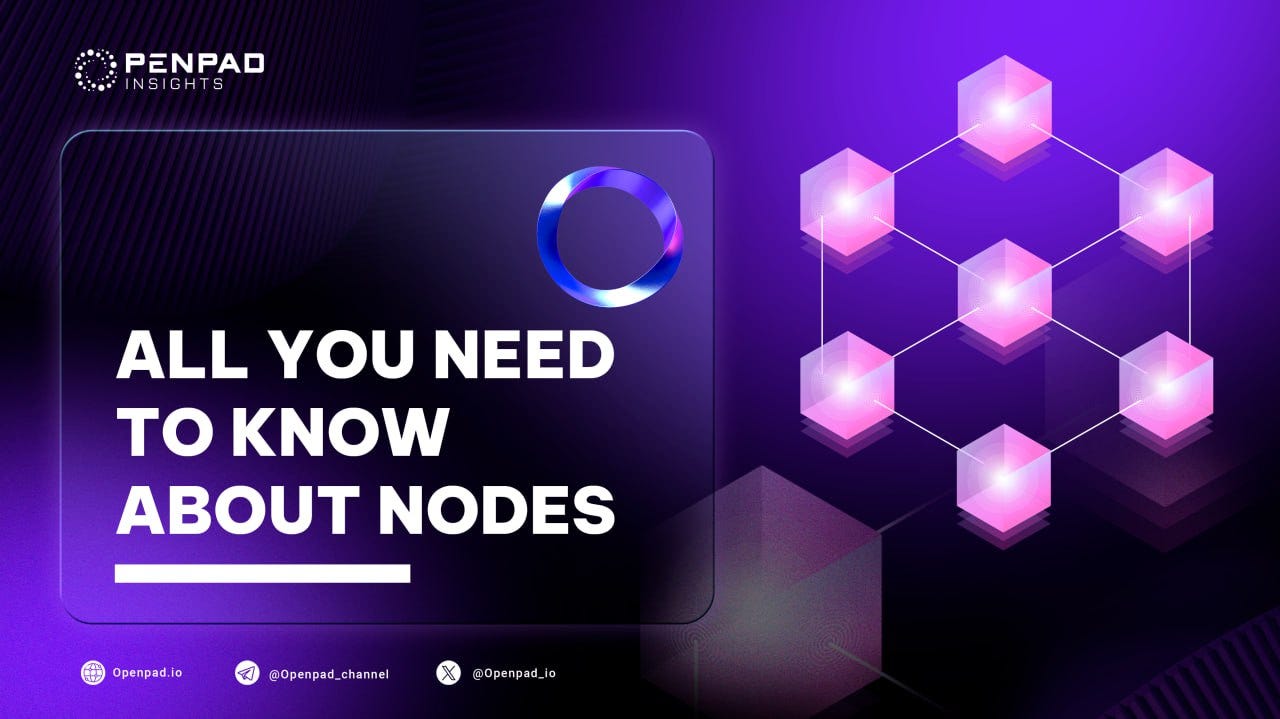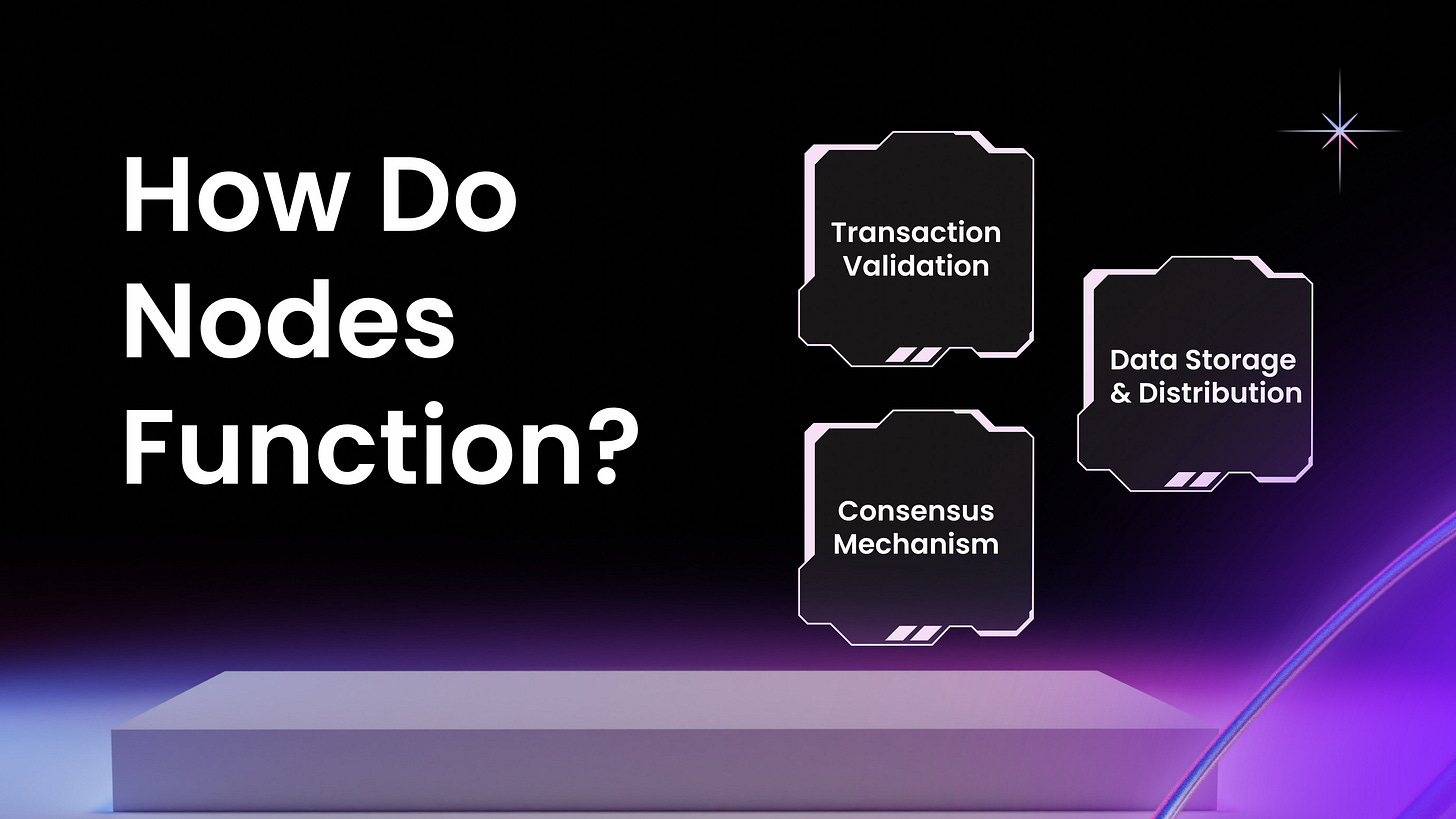All You Need To Know About Nodes
Navigating the Node Landscape: Key Insights for Investors in Web3
KEY TAKEAWAYS
Nodes ensure decentralization, security, and transparency by validating, storing, and sharing data.
Full, master, and light nodes serve distinct functions, supporting blockchain operations and governance.
Running nodes offers rewards, but investors must weigh costs, risks, and responsibilities.
The blockchain revolution is transforming industries by creating new growth avenues, and nodes are at the core of these networks, often overlooked by investors. Meanwhile, the rise of AI demands scalable computation, which traditional centralized models struggle to meet. Platforms like Node AI, Nillion, and Golem Network distribute workloads across interconnected nodes, boosting scalability and democratizing access to AI resources. Whether in AI or blockchain, nodes enhance efficiency and offer various benefits, including potential investment opportunities. This article breaks down what nodes are, how they function, and why understanding them is crucial for navigating the Web3 landscape.
What is a Node?
A blockchain node is a device, usually a computer, that participates in a blockchain network. It runs the blockchain protocol's software, allowing it to help validate transactions and keep the network secure. Unlike traditional systems, where a central authority manages all data (such as banks or corporations), decentralized blockchain networks distribute this responsibility among nodes. The more nodes there are, the more decentralized the network is.
Each node stores, shares, and often validates data blocks, ensuring that transactions are legitimate and the network remains secure and decentralized. Essentially, nodes serve as the backbone of a blockchain, preventing any single entity from exerting control over the entire system
Why Are Nodes Crucial?
A blockchain has no central authority, with control distributed across nodes that authenticate transactions and execute governance protocols. All tokens and smart contracts exist within nodes, making them essential to blockchain infrastructure. “Nodes are the source of truth for a blockchain,” said Nicholas Edmonds, lead blockchain engineer at Topl. More nodes strengthen decentralization, enhance network resilience, and make infiltration harder by outnumbering potential attackers
How Do Nodes Function?
There are three main purposes a node fulfills
Transaction Validation
Nodes validate transactions by ensuring the sender has sufficient funds and that transactions comply with network rules. Proposals undergo peer validation to determine whether they should be accepted into the blockchain or discarded. Once validated, transactions are distributed across the network to maintain accuracy and transparency.
Consensus Mechanism
Nodes play a critical role in consensus by collectively agreeing on the blockchain’s state through mechanisms like Proof of Work or Proof of Stake. Validator nodes help ensure synchronization and accuracy, while archival nodes store complete transaction histories. This decentralized coordination ensures network resilience, enabling scalable growth and interoperability across platforms like Polkadot.
Data Storage and Distribution
Nodes maintain the blockchain ledger and distribute it across the network to ensure transparency, decentralization, and protection against fraud or tampering.
Advantages of Operating and Managing a Node
Investing in nodes can offer several advantages, both financial and non-financial:
Earn Rewards: Many blockchain networks reward node operators with cryptocurrency. For instance, in Proof of Stake (PoS) networks, node operators can earn staking rewards by validating transactions, potentially creating a source of passive income.
Support the Network: Operating a node helps maintain the health and decentralization of the blockchain network. This is especially appealing to investors who are committed to the long-term value and growth of decentralized ecosystems.
Governance Opportunities: Some networks enable node operators, particularly masternode operators, to participate in governance decisions. This involvement allows you to influence the project's future direction, adding a layer of engagement beyond just financial returns.
Thanks for reading OpenPad. Subscribe for free to receive new posts.
What Are The Different Types Of Nodes?
Investors must understand that blockchain projects feature various node types with unique roles, requirements, and rewards. Researching these differences is vital for shaping effective investment strategies and maximizing returns.
Full nodes
Full nodes are the backbone of blockchain networks, storing the complete blockchain history, verifying transactions, and enforcing network rules. They are vital for maintaining consensus and functionality, contributing to decentralization and security. While running a full node requires significant hardware and bandwidth resources and typically doesn’t offer direct financial rewards, it ensures the network's reliability. Additionally, a majority of full nodes must agree on any proposed changes, which can lead to forks.
Master nodes
Masternodes are full nodes with custodial functions, maintaining the ledger and verifying new transactions without adding new blocks. Unlike basic nodes, they have additional responsibilities, such as executing instant transactions, participating in governance decisions, or managing decentralized applications (dApps). Individuals running masternodes can receive compensation in the form of free crypto, but it typically requires a significant investment, such as staking a large number of tokens. In return, masternode operators often earn higher rewards through transaction fees or network incentives, making them an attractive option for investors.
Light nodes
Light nodes are less resource-intensive and download only essential parts of the blockchain, relying on full nodes for complete data access. This makes them faster and easier to maintain, but they typically don’t earn the same rewards as full nodes. As the first type of non-full crypto nodes, their primary function is to communicate information and facilitate transactions. Although light nodes cannot validate new blocks, they play a vital role in supporting network functionality, making them a good option for investors seeking lower costs and simpler technical setups.
Key Considerations for Investors:
Different types of nodes come with varying levels of technical complexity, financial commitment, and potential rewards. Before making any investment decisions, it’s crucial to understand the specific role and requirements of the node associated with the project you’re interested in. This knowledge can help you assess the risks and benefits of your investment more effectively.
How Much Does It Cost to Run a Node?
The cost of operating a node varies significantly based on the type of node and the specific blockchain network. Here are some of the primary costs involved:
Hardware: Full nodes typically require more powerful computers with larger storage capacities, while light nodes can function on standard computers. The specifications will depend on the network requirements.
Electricity: Operating a node continuously (24/7) can lead to notable electricity expenses, especially if it's a full node that requires substantial processing power.
Staking Costs: For masternodes, there is often a requirement to stake a significant amount of the project's cryptocurrency, which can represent a considerable initial investment.
For smaller investors, some networks offer shared masternodes, allowing multiple investors to pool their resources to run a node. This arrangement not only splits the rewards but also reduces the entry barriers for participation.
Final Thoughts on Nodes
Nodes are the backbone of blockchain networks, ensuring decentralization, security, and transparency by storing, validating, and distributing data without central authorities. With various types—like full nodes, master nodes, and light nodes—each plays a crucial role in maintaining the blockchain ecosystem’s integrity. As Web3 evolves, nodes will become even more vital to decentralized systems. For investors seeking a deeper involvement beyond token investments, running a node offers a hands-on opportunity with potential rewards. However, it’s essential to understand the requirements, responsibilities, and risks before diving in.








